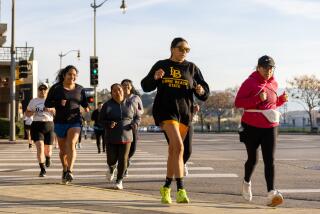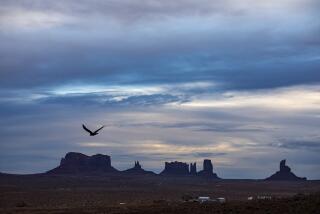At Indian Pueblo, Running Is a Religion : Tradition: Generations of residents have loped tirelessly across the desert. The activity provides a time for meditation.
- Share via
JEMEZ PUEBLO, N.M. — You never see spandex pants or stereo headphones out here where the hills are made of red sandstone and dotted with junipers and rabbit brush.
There are no plastic squeeze bottles, no pink shoelace pom-poms.
Out here, where North America’s civilization was born, where rattlesnakes lurk in the rope cactus and hawks patrol the sun-scorched sky, there are no joggers--only runners keeping an ancient tradition alive.
“Sometimes, when things are really bad, I will go out there and cry as I run,” said David Simone, a Navajo whose grandfather taught him the tradition.
“Running is as much a religion as a therapy,” Simone said.
“With the sky as my roof, the sun to give me energy, I do not think about the alcoholism, the young girls with babies, the lack of jobs.”
At the Jemez Pueblo, where houses are the same rust red as the surrounding hills, life is hard. There are few jobs and little money.
Old women, their faces tanned like leather from the sun, fry bread on wood fires at roadside stands for tourists headed across the desert for glamorous Santa Fe or Colorado’s Rocky Mountains.
Men gather in small groups to drink.
The pueblo Indians of New Mexico have been running for hundreds of years.
In the early times, before Europeans arrived, they had no horses. Although horses and camels originated in North America, by the end of the last Ice Age they had died out.
So the pueblo Indians would run to deliver messages, to hunt for meat, and for recreation.
But running was always a religious focal point, a time of meditation and reflection as well.
Bart Humphrey, part Navajo and part Tewa, runs at dawn.
“My grandfather told me to run every morning, before sunrise, toward the sun,” Humphrey said.
“If you run in the morning, you absorb all the freshness of the day,” he said.
The great runners--like Frank Shorter and Billy Mills--dubbed Steve Gachupin the King of the Mountain. But these days Gachupin’s body rebels when he starts his running.
At 48, age is stiffening him, stealing his speed, his stamina. But he fights back, running every day.
There is no talking while he slips into his blue jeans and a cheap pair of sneakers.
He stretches for a few moments before setting out at a hot pace along a dusty dirt road winding through Indian lands seldom seen by outsiders, far from the pavement that brings the tourists.
“Each runner has his own way of seeking blessings,” he said. “I breathe the fresh air and say a prayer of my own.”
Gachupin was the first man to run the grueling 28-mile marathon up the 14,000-foot-high Pike’s Peak in Colorado without stopping.
He won the race six times between 1966 and 1971. He also won the agonizing La Luz run five times--up the backside of the 10,600-foot-high Sandia Mountains in Albuquerque.
“Jemez has always had good runners,” Gachupin said. “It goes way back to the messengers.”
Not as many run now as in years past. Membership in running clubs has shrunk. The days of Indians dominating the state’s high school tournaments are gone.
Stan Byrd, a high school coach, said times have changed.
“They used to run with long, flowing hair,” he said. “Now they’ve started looking like white kids.”
But he keeps trying to inspire fresh greatness.
“They have a saying: ‘He who runs races is the life of the people,’ ” Byrd said.
A New Mexico writer recently summed up the tradition.
“The sound is faint,” wrote Ed Johnson in the Albuquerque Journal. “It is a lone, lonely sound.”
“It is the sound of ancient Indians running. It is one of the oldest echoes New Mexico knows.”
More to Read
Sign up for The Wild
We’ll help you find the best places to hike, bike and run, as well as the perfect silent spots for meditation and yoga.
You may occasionally receive promotional content from the Los Angeles Times.






